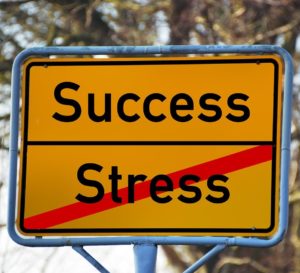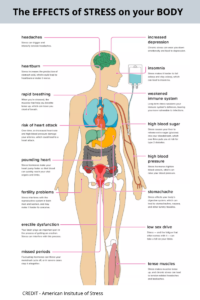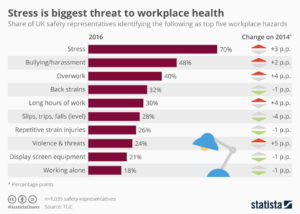Discover the latest trends and how it affects business productivity.
 It’s a worldwide phenomenon and the statistics are alarming!! The AIS (American Institute of Stress) recently reported that a staggering 550 million working days are lost every year due to stress-related absence from work.
It’s a worldwide phenomenon and the statistics are alarming!! The AIS (American Institute of Stress) recently reported that a staggering 550 million working days are lost every year due to stress-related absence from work.
The number of people who call in sick because of stress is claimed to have increased by close to 75% in just the past few years with approximately 1 million workers every day absent from work. It’s reported that 1 in 5 no-shows at the last minute are also linked to stress.
Before I delve further into this topic, I must first make the very important distinction between ‘being challenged’ and ‘being stressed’. When being challenged, I personally perceive this as positive stress which can help to improve performance and productivity, however, it should only ever be a temporary situation as severe, frequent, or prolonged pressure can significantly impact overall health. Every one of us has their own individual coping mechanisms in response to stress and understanding your own personal stress triggers is crucial to gaining back control of your behavior.
Reactive stress, on the other hand, (which can be viewed as negative) is very much based on our emotional memories and is formed from behaviors and actions as a result of an external situation that you perceive as stressful, or in other words – based on FEAR. We can become overwhelmed when we are unable to distinguish between positive and negative stress. Furthermore, it is crucial to understand that stress is highly individualized and consequently undertaking a “one size fits all” approach to stress management is completely flawed.
BUT CAN’T MY STAFF LOOK AFTER THEMSELVES? WHY SHOULD I CARE?
Well, you should always care, it’s your duty of care. Workplace health experts are reporting work-related stress to be a major drain on job satisfaction, employee productivity, and overall business growth. Medical researchers estimate that chronic stress is responsible for 90% of illness and disease and is being projected to be the health epidemic of the 21st Century. Stress is linked to many of the major leading causes of death: heart disease, stroke, cancer, lung ailments, accidents, cirrhosis of the liver, and suicide. 
The adverse effects of stress on employees can no longer be ignored and there is a ‘human resources’ shift gaining momentum in regards to protecting your greatest business asset, YOUR STAFF.
There is good news however, it’s not all “doom and gloom” as stress is manageable, reducible and reversible.
WHY HAS THE CORPORATE LANDSCAPE CHANGED?
To put it simply … overburden! In today’s rat race our traditional coping mechanisms are pushed to the limits on a daily basis, both professionally and personally. Due to the ever-growing concern of job insecurity, many employees are now working longer hours to meet KPI’s and deadlines to improve their ‘chance’ of any potential promotions. As a result, this long-term physical, mental and emotional strain places huge psychological demands on staff to succeed resulting in high levels of stress.
STRESS – “a condition or feeling when a person perceives that demands exceed the personal and social resources the individual is able to mobilize.”
WHAT MAKES A HEALTHY WORKPLACE?
According to the World Health Organisation, 2009. Healthy workplaces: a model for action, a healthy workplace is defined as the following :
“A healthy workplace is one in which workers and managers collaborate to use a continual improvement process to protect and promote the health, safety, and wellbeing of all workers and the sustainability of the workplace.”
Ask yourself this question, “Is my business being pro-active?”
Stress occurs in a wide range of work circumstances and current research findings show that the most stressful type of work environment is one that places excessive demands and pressures on staff that is not matched with their knowledge, abilities and skill set. Work-related stress is further compounded when employees feel they have little support from supervisors and colleagues, as well as little control over work processes, plus unsatisfactory on-boarding and on-the-job training, poor performance management systems and lack of communication.
Simply reacting to the fallout of work-related stress is not the answer. To achieve a health-conscious culture within your business, you must take a pro-active and holistic approach to the health and wellbeing of your staff through the implementation and promotion of Workplace Health Programs (WHP).

Stress is the leading cause of job burnout and dissatisfaction and is costing your business significantly. Don’t believe me? Check out these base-line statistics:
- Approximately 20% of Americans admit they are under constant stress.
- Every year it is estimated that 110 million people die from stress.
- Absenteeism due to sickness is costing Australian businesses $7 billion annually.
- This equates to approximately $1,000 per employee per year.
- Presenteeism costs a staggering 4 times more at $26 billion annually.
- Stress-related claims are costing Australian businesses more than $200 million annually.
The statistics don’t lie. Stress is a major factor affecting the health and wellbeing of you and your employees and ultimately business productivity and growth. If you want to protect your bottom line, you need to start creating a health-conscious culture in which there is not only an absence of harmful conditions but an abundance of health-promoting options.


